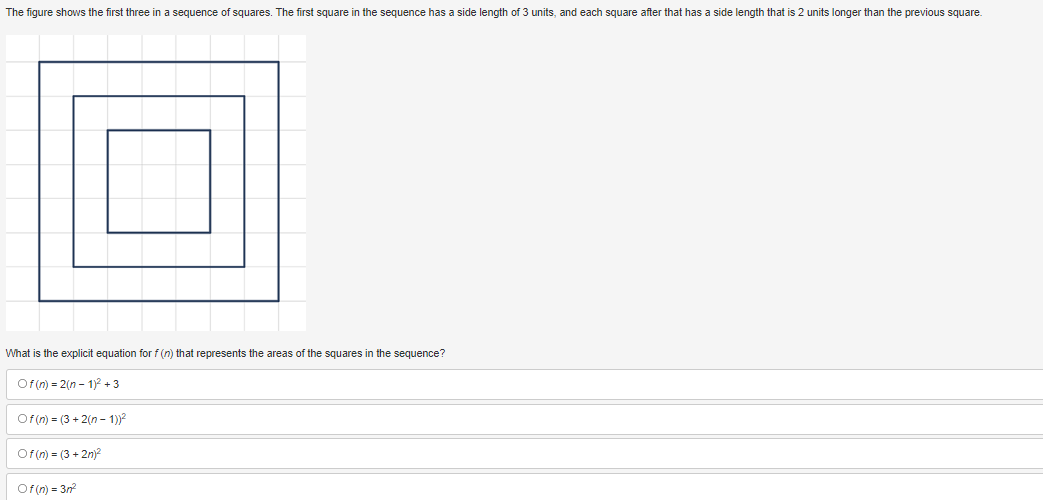The figure shows the first three in a sequence of squares. The first square in the sequence has a side length of 3 units, and each square after that has a side length that is 2 units longer than the previous square. What is the explicit equation for f(n) that represents the areas of the squares the sequence? Of(n) = 2(n-1)² +3 Of(n)=(3+2(n-1))² Of(n)=(3+2n)² Of(n)=3n²
The figure shows the first three in a sequence of squares. The first square in the sequence has a side length of 3 units, and each square after that has a side length that is 2 units longer than the previous square. What is the explicit equation for f(n) that represents the areas of the squares the sequence? Of(n) = 2(n-1)² +3 Of(n)=(3+2(n-1))² Of(n)=(3+2n)² Of(n)=3n²
Algebra & Trigonometry with Analytic Geometry
13th Edition
ISBN:9781133382119
Author:Swokowski
Publisher:Swokowski
Chapter10: Sequences, Series, And Probability
Section10.1: Infinite Sequences And Summation Notation
Problem 16E
Related questions
Question

Transcribed Image Text:The figure shows the first three in a sequence of squares. The first square in the sequence has a side length of 3 units, and each square after that has a side length that is 2 units longer than the previous square.
What is the explicit equation for f(n) that represents the areas of the squares in the sequence?
Of(n) = 2(n-1)² +3
Of(n)=(3+2(n-1))²
Of(n)=(3+2n)²
Of(n) = 3n²
Expert Solution
This question has been solved!
Explore an expertly crafted, step-by-step solution for a thorough understanding of key concepts.
This is a popular solution!
Trending now
This is a popular solution!
Step by step
Solved in 2 steps with 2 images

Recommended textbooks for you

Algebra & Trigonometry with Analytic Geometry
Algebra
ISBN:
9781133382119
Author:
Swokowski
Publisher:
Cengage

Elementary Linear Algebra (MindTap Course List)
Algebra
ISBN:
9781305658004
Author:
Ron Larson
Publisher:
Cengage Learning

Algebra & Trigonometry with Analytic Geometry
Algebra
ISBN:
9781133382119
Author:
Swokowski
Publisher:
Cengage

Elementary Linear Algebra (MindTap Course List)
Algebra
ISBN:
9781305658004
Author:
Ron Larson
Publisher:
Cengage Learning